Emily Lakdawalla • Feb 18, 2014
What are Mercury's hollows?
Whenever I talk about the MESSENGER mission to Mercury, one discovery that I always mention is these strange features that the science team has dubbed "hollows." Nothing quite like them has been seen on any other world. A geomorphic mystery, they're irresistible to geologists: a wholly new kind of landform to explain, unique to the innermost planet. Here's one example of what hollows look like, close-up:
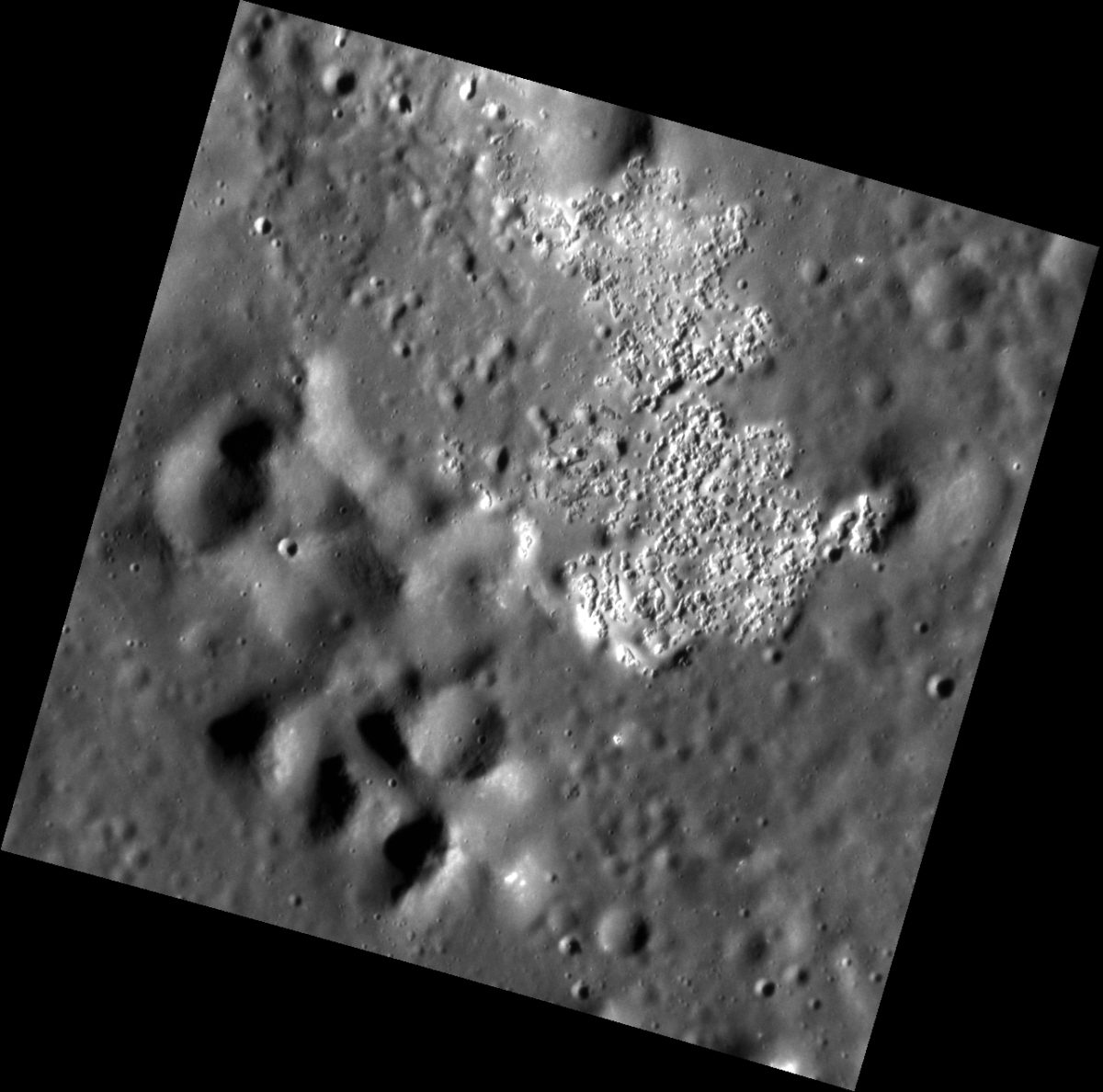
There have been several papers published on hollows in the last year, and I thought it was time to read them and see what scientists think they are. There are two papers in particular that I'm looking at. The first one, published in 2013 by David Blewett and a host of coauthors, describes hollows and the geologic settings in which they occur. The second one, published in 2014 by Rebecca Thomas and three coauthors, uses a quantitative approach to try to figure out what factors encourage the formation of hollows.
Hollows were first noticed in Mariner 10 photos, but the images were not detailed enough to show scientists what they really were. In a special Mariner 10 issue of Physics of the Earth and Planetary Interiors from 1977, Peter Schultz described the distinctive features:
Numerous craters on Mercury exhibit distinctive contrasts among the floor, wall, and rim regions. The 120-km-diameter crater Zeami (148°, -2°), as an example, contains both smooth dark plains materials and bright ill-defined patches. Superposition relationships between these light patches and dark plains cannot be determined with confidence owing to inadequate resolution; however, the narrow irregular extensions of dark material between the bright patches suggest encroachment by the dark plains.
Mariner 10 images are very easy to browse, thanks to the terrific Mariner 10 Image Archive at Arizona State University. Just select a feature name from the dropdown list on the advanced search page and you're there. Here's what Zeami looked like from Mariner 10. It's intriguing, but trying to figure out what those bright splotches on the floor of the crater are is like looking at a Rorschach inkblot.

Thanks to MESSENGER, we get much better views of this intriguing terrain. The MESSENGER data is also super easy to search. I went to the Quickmap, toggled the latitude/longitude grid, and zoomed in to the location of Zeami. Click on the little wrench at the upper right of the screen and you can get a box tool or a polygon tool to draw a region of interest on the map. Click on the region of interest and select the Query tool, then you can select the kind of data you want to download. I found a set of 10 narrow-angle camera images covering the crater, and stitched them together in Photoshop. Then I found color data from this public image release and overlaid it to produce this photo.
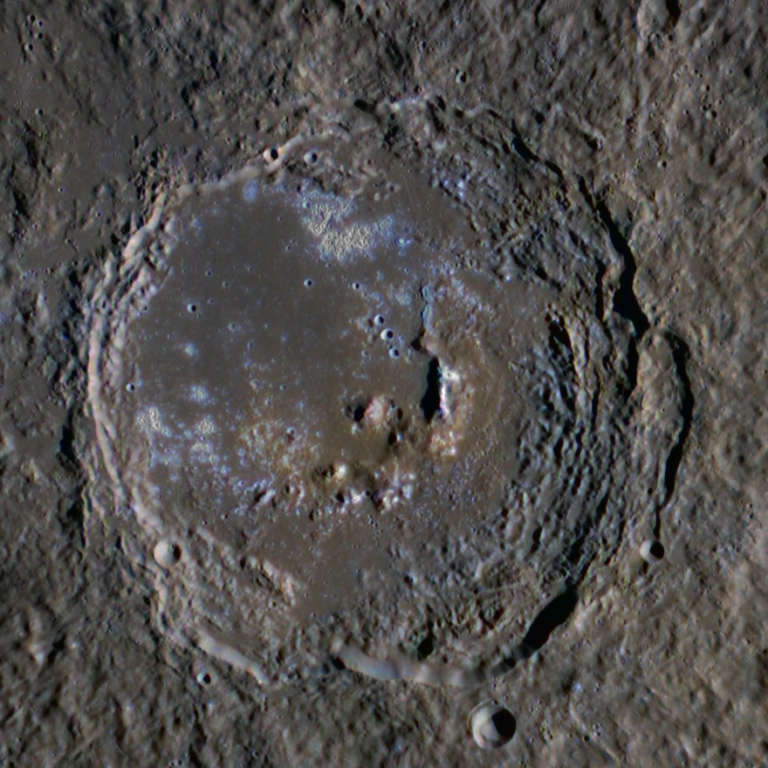
Quite a difference, eh? We can immediately learn two things about the funky bright colored splotches inside Zeami. First, they tend to have a distinctive blue color in the MESSENGER team's preferred type of false-color images. Second, they are depressions in the floor of the crater -- you can tell that from the locations of the shadows inside them -- but they are definitely not impact craters. You can see lots of little impact craters inside Zeami's floor; they have a textbook bowl shape. The hollows look kind of like the surface is being eaten away, like someone splashed acid inside the crater. Everywhere on Mercury, the bright, bluish material located inside craters has a similar appearance.
The Thomas et al. paper defines hollows as"sub-kilometer scale, shallow, flat-floored, steep-sided rimless depressions typically surrounded by bright deposits and generally occurring in impact craters." Their appearance is distinctly different from that of volcanic pits, which Mercury also has in abundance. Volcanic pits are deeper than hollows and have irregular floors, while hollows are shallow and have flat floors.
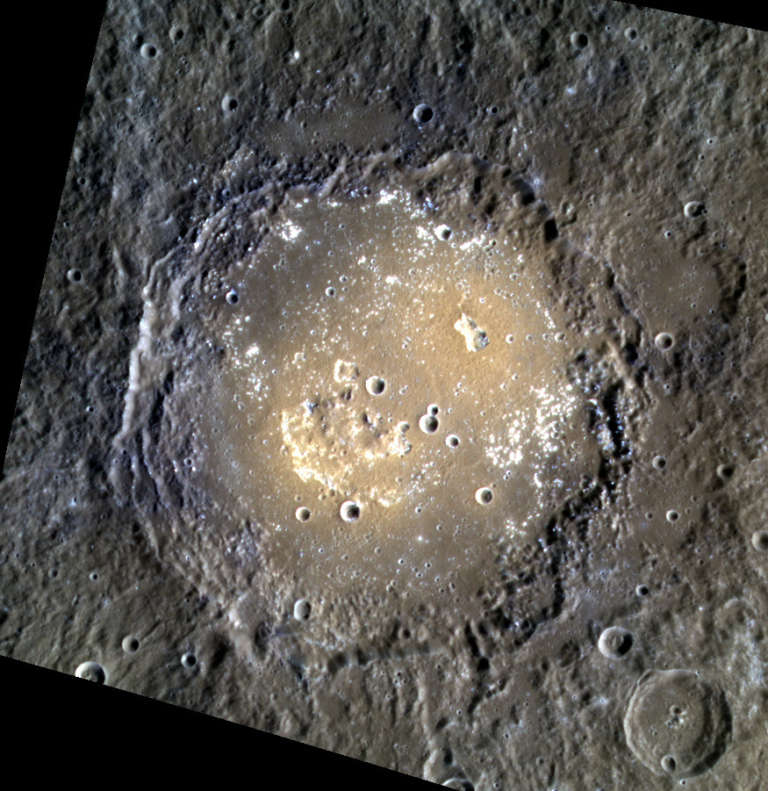
There don't seem to be any places where there are impact craters on top of hollows, meaning that they're young, very young; they may possibly be forming today. Blewett et al. find that most hollows are found inside craters, but there are some exceptions. In general, the hollows seem to be found near another distinctive kind of Mercury surface, which the MESSENGER team has called "low reflectance material" and tends to abbreviate "LRM." You guys know how I feel about acronyms and initialisms. I'm going to call it "dark stuff". Blewett also reported a tendency for hollows to occur in only certain parts of craters -- like equator-facing rims. Or on craters near Mercury's "hot poles." (Because of Mercury's strange spin-orbit resonance and elliptical orbit, the longitudes 0° and 180° receive much more solar heating than the longitudes 90° and 270°; these longitudes are called the "hot poles" and "cold poles," respectively.) Those geographic trends are intriguing, because the part of a crater rim that faces the equator gets more direct sunlight than the part that's facing away from the equator. Do hollows result from solar heating of the surface somehow?
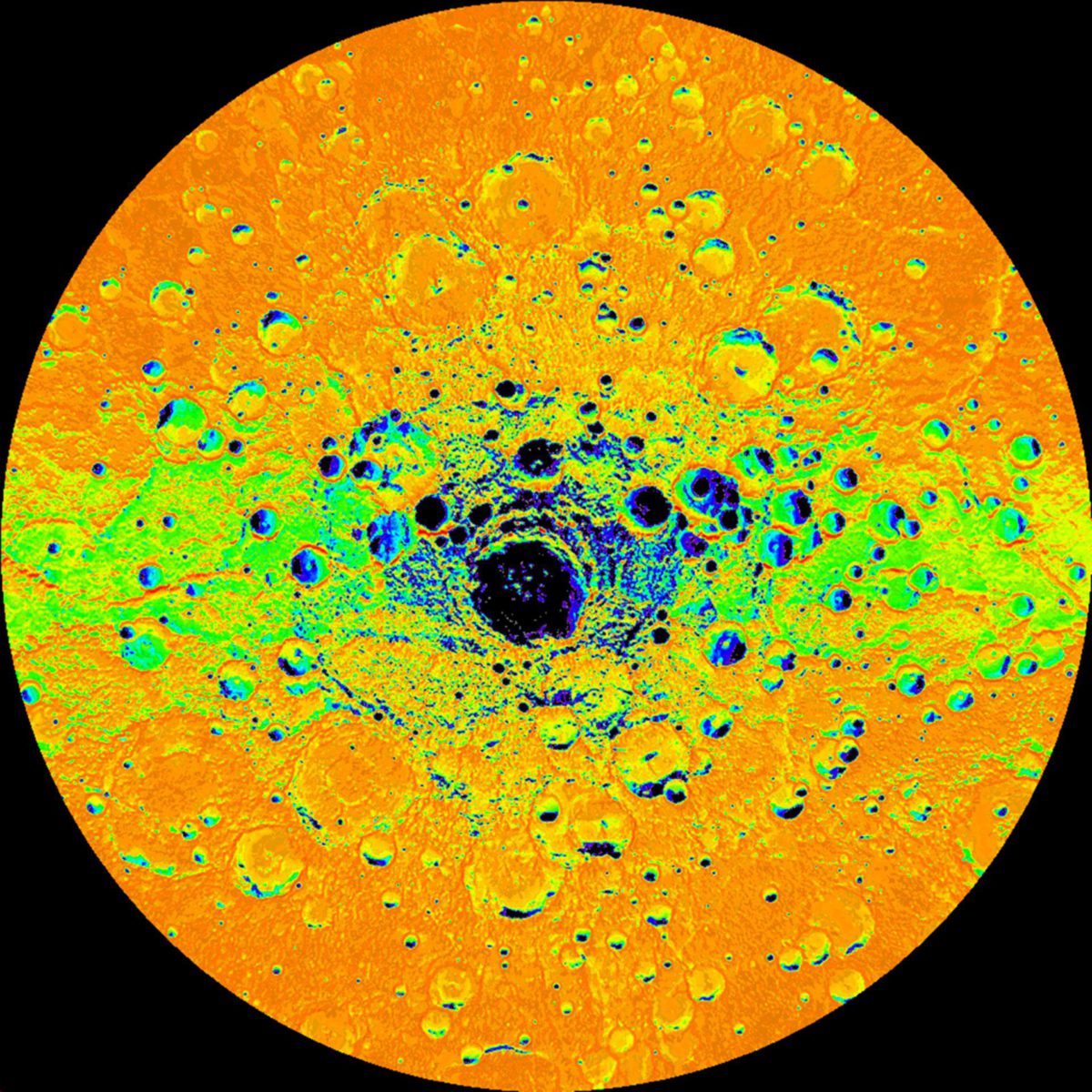
Although hollows are often found in craters, they aren't exclusively found in craters. They're also sometimes found out in the plains, outside any crater. Even in craters, they can be found in all different parts of a crater: floor, central peak, wall, rim, ejecta. The fact that they're found in so many places suggests that they have something to do with a particular kind of material being exposed at the surface rather than a particular geologic process.
The Thomas et al. paper is similar to the Blewett et al. one, except that Thomas' approach is a bit more numerical and rigorous. They systematically mapped hollows and pits all over the planet, looking at every single MESSENGER photo with sufficient resolution, and found the following trends:
- 0.08% of the surface is covered by hollows, in 445 groups (this compared to 140 groups analyzed in the Blewett paper). They also noted 173 groups of pits and 24 areas of pitted ground, which are distinct from hollows.
- Hollows are noticeably lacking (though not absent) in the high northern latitude high reflectance plains and in Caloris basin and Rembrandt.
- They are also not seen at high southern latitudes, but because of MESSENGER's elliptical orbit, the image coverage in this area may not be high enough resolution.
Thomas asked whether the geographic trends observed by Blewett et al. were real or not, looking at the area covered by hollows in different latitude and longitude bins. First: are there more hollows near the hot poles? They found that yes, indeed, there's a trend for more hollows to be found close to the hot poles, 0° and 180°, than at the cold poles, although there are hollows at all longitudes; clearly, whatever enhances hollow formation near the hot poles does not prevent them from forming near the cold poles.
What about the suggestion that there are more hollows on equator-facing slopes? Thomas pointed out that a lot of the time, hollows only seem to be on equator-facing slopes because the pole-facing slopes are shadowed, so we simply can't see whether or not there are any hollows there! But in some images it is possible to see the pole-facing slope, and in 8% of these cases, they did preferentially form on the equator-facing slope. But that's clearly not a very strong correlation. "[M]ost hollows are found on flat surfaces or on slopes of opposing aspects within a group so we do not find that preferential formation on sun-facing slopes is a common characteristic of hollows."
One thing Thomas et al. noticed was a very strong correlation between the location of volcanic pits and hollows: there are hollows located close to 74% of the pits that Thomas identified at high resolution. They also confirmed the trend that Blewett et al. noticed of hollows occurring close to dark stuff. More specifically, "The hollows incise the low-reflectance material and are floored and/or haloed by bright relatively blue material." They pointed out a really cool illustration of this: a crater that hit the boundary between darker plains and brighter plains. Inside this crater, there are hollows -- but only in the half of the crater that crosses the darker plains.
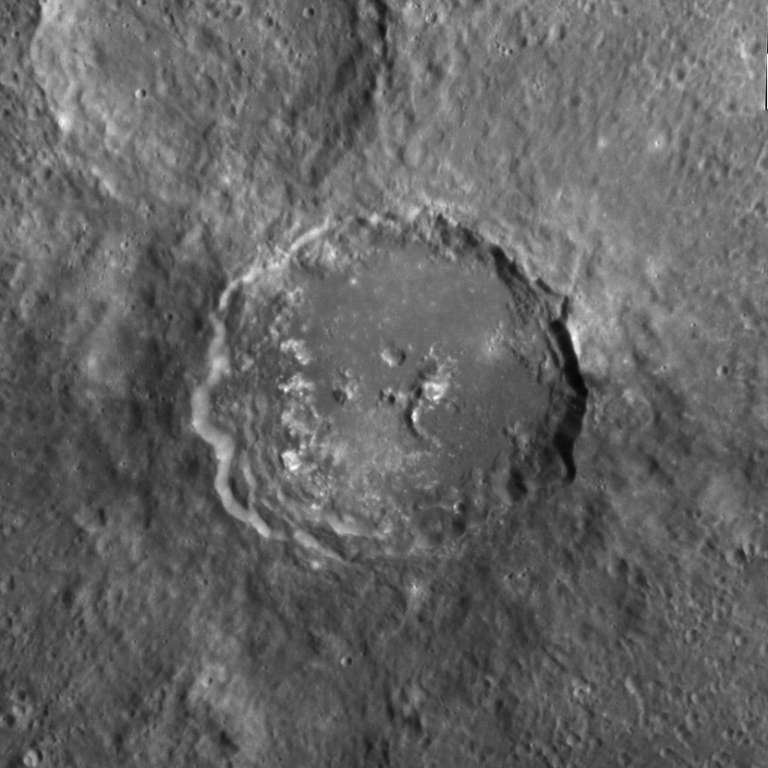
What to make of all of these associations? The two papers reached similar conclusions. Everyone seems to agree that hollows form when something in Mercury's surface sublimates (turns from solid to gas). It would make sense for this to happen more readily in places that get more solar insolation, like the hot poles and equator-facing slopes. One slight worry is that there should also be a trend of more hollows closer to the equator -- that association should be stronger than the association with the hot poles, but this wasn't a strong result in the Thomas et al. paper. It is hard to find latitudinal trends in MESSENGER data because the orbit altitude varies so much, though. Still, even the association with hot poles and equator-facing slopes is not very strong. Hollows can, and do, form at any latitude and on any kind of slope.
Instead, Thomas et al. point to the association of hollows with volcanic pits. Volcanism would've come with heat, so maybe volcanic heat enhanced whatever process it is that makes hollows form: "If magmatic activity was contemporaneous with hollow formation at these sites, the heat of subsurface magma may have mobilized the volatile component of the host rock. This component may either ascend to the surface, condense and later be removed by sublimation, possibly aided by heat from below, or ascend as a gas and cause hollows to form by collapse of surface material due to volume loss in the underlying substrate." They found evidence for both processes in different types of hollows on the planet.
But most hollows aren't found near volcanic pits; they're found near craters, in places where material has been excavated from depth (like in crater peaks, peak rings, and walls). Thomas et al hypothesize that the craters are exposing some special hollow-forming material from depth, likely the "low-reflectance material" that's found across Mercury. This may be regular Mercury plains that is darkened by some unknown material, a material that also can sublimate to cause hollow formation.
What is this material? Alas, it doesn't look like MESSENGER is going to be able to tell us. MESSENGER has done a fantastic job performing our first survey of the innermost planet, but it can't do everything. In space missions there are always trades between resolution and areal coverage: if you want to cover the whole planet, you have to do it at lower resolution; if you want high-resolution data, you don't get to cover the whole planet. This holds true for both spatial resolution (smaller pixels means higher resolution but it takes more pixels to cover the same area) and spectral resolution (more ability to distinguish color often trades against spatial resolution). Before MESSENGER, we didn't know what most of Mercury looked like. Thanks to MESSENGER, all of Mercury has been mapped for the first time. Blewett and Thomas and others have systematically surveyed the planet and told us where some of Mercury's most intriguing geology is. Following up on those discoveries will be the work of the next mission: BepiColombo, which is now under construction for a planned July 2016 launch and January 2024 arrival -- that's ten years from now, wow.
MESSENGER is not quite dead yet, though. Not by a long shot, actually. As the mission is now in its second extension, the spacecraft is dipping lower and lower in its orbit, which brings its camera (and other instruments) closer, narrowing the field of view and increasing the resolution. Thanks to the global maps they've developed, they're able to zoom in ever-tighter on Mercury's intriguing surface features. The mosaic below is one such low-altitude observation, of a small crater with hollows exposed emanating from a particular layer exposed in its wall. So there's much more to come from MESSENGER!
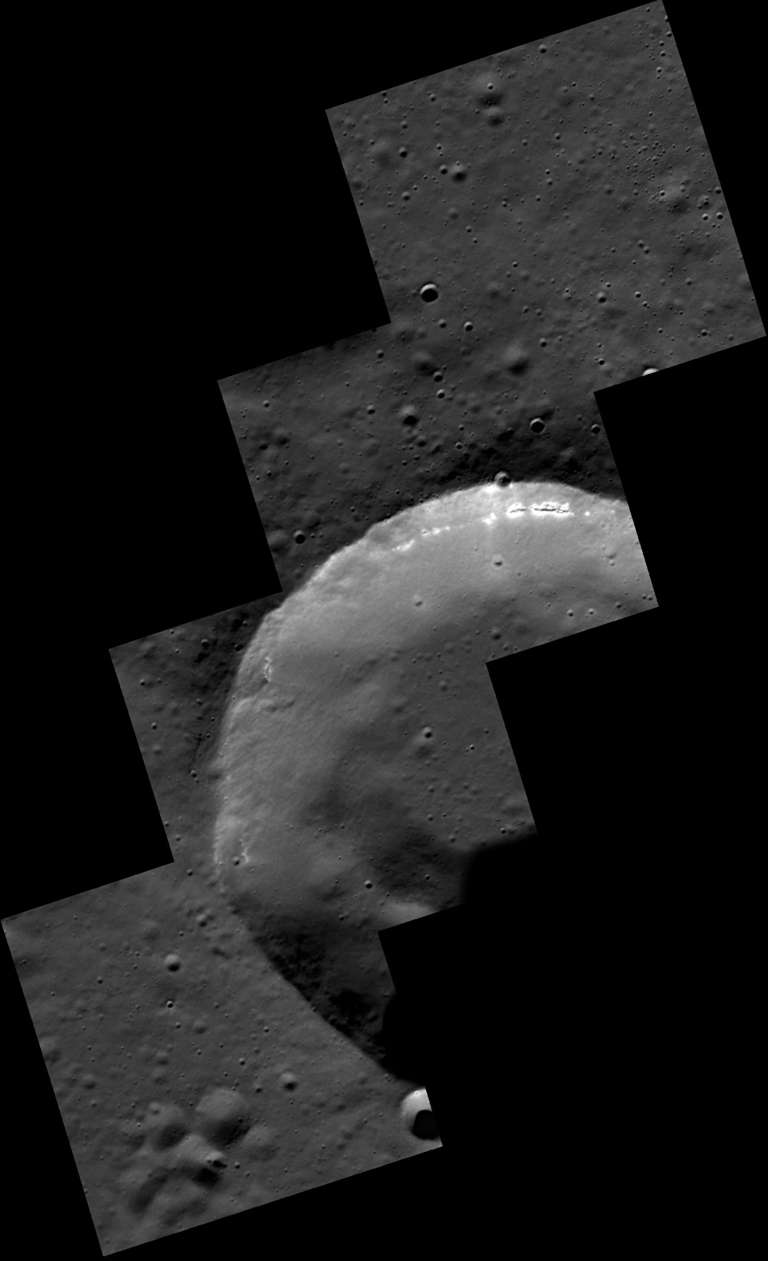
Let’s Go Beyond The Horizon
Every success in space exploration is the result of the community of space enthusiasts, like you, who believe it is important. You can help usher in the next great era of space exploration with your gift today.
Donate Today

 Explore Worlds
Explore Worlds Find Life
Find Life Defend Earth
Defend Earth

